- News
- Reviews
- Bikes
- Accessories
- Accessories - misc
- Computer mounts
- Bags
- Bar ends
- Bike bags & cases
- Bottle cages
- Bottles
- Cameras
- Car racks
- Child seats
- Computers
- Glasses
- GPS units
- Helmets
- Lights - front
- Lights - rear
- Lights - sets
- Locks
- Mirrors
- Mudguards
- Racks
- Pumps & CO2 inflators
- Puncture kits
- Reflectives
- Smart watches
- Stands and racks
- Trailers
- Clothing
- Components
- Bar tape & grips
- Bottom brackets
- Brake & gear cables
- Brake & STI levers
- Brake pads & spares
- Brakes
- Cassettes & freewheels
- Chains
- Chainsets & chainrings
- Derailleurs - front
- Derailleurs - rear
- Forks
- Gear levers & shifters
- Groupsets
- Handlebars & extensions
- Headsets
- Hubs
- Inner tubes
- Pedals
- Quick releases & skewers
- Saddles
- Seatposts
- Stems
- Wheels
- Tyres
- Health, fitness and nutrition
- Tools and workshop
- Miscellaneous
- Tubeless valves
- Buyers Guides
- Features
- Forum
- Recommends
- Podcast
review
£1,250.00
VERDICT:
Stiff, ruthless race machine that delivers the power at a sensible price; can be a bit on the harsh side
Weight:
8,170g
Contact:
At road.cc every product is thoroughly tested for as long as it takes to get a proper insight into how well it works. Our reviewers are experienced cyclists that we trust to be objective. While we strive to ensure that opinions expressed are backed up by facts, reviews are by their nature an informed opinion, not a definitive verdict. We don't intentionally try to break anything (except locks) but we do try to look for weak points in any design. The overall score is not just an average of the other scores: it reflects both a product's function and value – with value determined by how a product compares with items of similar spec, quality, and price.
What the road.cc scores meanGood scores are more common than bad, because fortunately good products are more common than bad.
- Exceptional
- Excellent
- Very Good
- Good
- Quite good
- Average
- Not so good
- Poor
- Bad
- Appalling
Looking through Hersh's description of the Speed you won't see comfort mentioned anywhere; this bike is about power transfer, handling and being ridden hard. In short, it lives up to its name.
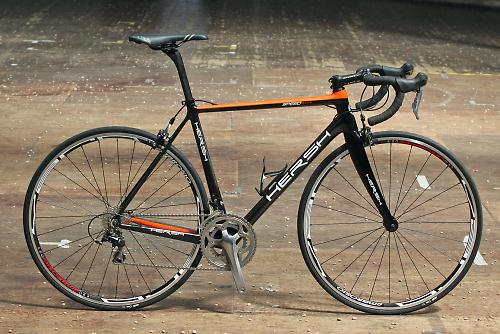
Italian company Hersh offers a small selection of carbon road bikes in the UK along with a time trial bike and a steel fixie with a focus on customization. Whether you tweak the components, paint or even geometry on some models, the idea is that you can create a bit more of a bespoke ride than just accepting a full-on off the peg model.
The Speed is a frame of two halves. The front triangle is oversized with a 1 1/8in to 1.5in tapered head tube and a massive 55mm wide, diamond-profile down tube. The biggest thing of note, though, is the bottom bracket area, which actually eclipses the 34-tooth inner ring. Hersh have gone for a push fit BB30 which allows them to go wider at the BB shell as there are no outboard bearings needed for the chainset.
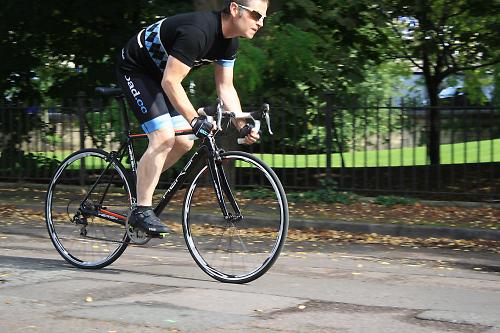
Using one of the highest tensile strength carbon materials, Toray's T800, means the combination of that and the large tube profiles creates a massively stiff frame. Sprinting, climbing, anything where you are really stomping on the pedals reflects the solidity of the frame and it really delivers your power to the road.
The £2,000 Shimano 105 build we've got here hasn't got the lightest of components on board but the low frame weight shows through on the climbs and with the narrow Ritchey bars the Hersh really loves to attack the climbs, especially those where you need to be out of the saddle. In fact it doesn't feel like it weighs 8.2kg (18lb) at all thanks to how efficient it is.

Low and long could be used to describe the geometry as its very much a racer's cut. The 53cm we've got has a seat tube of 52cm and an effective top tube of 54.6cm on this compact frame. The 15cm head tube sounds longer than it is as the slammed stem stance here means there's a good drop from saddle to bars.
Descending and cornering is solid and dependable thanks to a short wheelbase of just 983mm and a slightly slacker head angle of 72° than I was expecting to see. It does keep the steering controllable, though, especially on suspect road surfaces as the handling isn't quite so twitchy. The Speed holds a line well and crouched in the drops you can get the top speed up without having to worry about making it round the next bend. The full carbon fork matched the frame with very little in the way of flex. Really load the front end up and you couldn't upset it at all.

The trade-off of all this stiffness though is it ain't all that comfortable. It's not uncomfortable, just on the harsh side for anything over three or four hours. The rear end, especially the seat stays are very thin to absorb as much shock as possible and they do a good job of stopping your rear end from taking to much of a kicking. A lot of carbon seatpost poking out of the frame helps to though you can go for an optional integrated post version. It's the front end where the damage is done, the wrists and hands especially.
As I've mentioned this is the 105 build which offers a full groupset, Ambrosio wheels and Ritchey finishing kit. It's a sensible entry level into the Hersh range working well with the Speed frame and you can upgrade the parts as you go. The Ambrosio wheels were a very nice ride with smooth hubs and they stayed true throughout the test period. They are heavy though. We swapped out the standard wheels for some deep section carbons for a couple of rides and that really gave the Hersh a new lease of life.
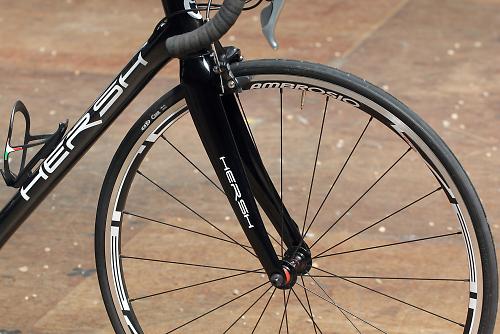
There is also an Ultegra build (£2,250) Dura Ace (£3,500) or if SRAM tickles your fancy there are Force and Red builds for £2,300 & £3,500 respectively. You can even go your own way with a frame & fork option for £1,250. On the face of it, it all looks pretty good value for money as the frame is well built with plenty of neat little touches. It'll take both mechanical and electronic groupsets thanks to tidy internal cabling and no redundant cable stops and you also get a replaceable gear hanger which in my eyes is a must on any expensive frame. To finish things off you can have the Speed painted in any colour you want at the factory and the orange highlights on ours look smart and well finished.
The Hersh Speed is one for the club chain ganger or weekend racer as it loves to be ridden hard and will respond to whatever you ask of it. You need to be the type of rider that can take a bit of rattling about over the potholes. This is exactly what Hersh set out to create though: a thoroughly ruthless speed machine that puts out what you put in.
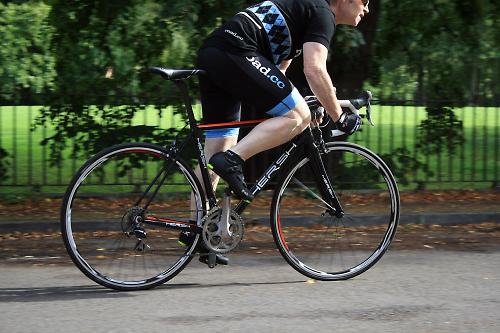
It can be a little lacking in communication sometimes like a lot of ultra stiff carbon bikes but the balance of sensible geometry and a calm rear triangle means the Hersh won't put you into any sort of trouble that can't be gotten out of easily.
This 105 build is a good starting point though a change to a lighter set of wheels will pay dividends and completely changes the climbing abilities of the Speed.

If you're intrigued Hersh will be displaying their bikes at the Cycle Show next month.
Verdict
Stiff, ruthless race machine that delivers the power at a sensible price; can be a bit on the harsh side
road.cc test report
Make and model: Hersh Speed
Size tested: 55
About the bike
State the frame and fork material and method of construction. List the components used to build up the bike.
T800 High Modulus frame & Fork
Ambrosio Varo Wheelset
Shimano 105 Groupset
Ritchey stem & handlebars
Carbon seatpost
Tell us what the bike is for, and who it's aimed at. What do the manufacturers say about it? How does that compare to your own feelings about the bike?
Hersh make no bones about the fact that the Speed is all about performance, whether that be on the flat, descending or climbing. Thats what they've created, a tight, stiff, surefooted road bike that's a blast if ridden hard.
Frame and fork
Overall rating for frame and fork
8/10
Tell us about the build quality and finish of the frame and fork?
Well finished and will work with both mechanical and electronic grousets. The varying tube profiles seem to blend well together considering virtually every one is a different shape.
Tell us about the materials used in the frame and fork?
T800 has a very high tensile strength allowing for a stiffer frame to be built with less material, therfore lighter. There are obviously trade offs as we've seen here with regards to comfort due to the frame not flexing much.
Tell us about the geometry of the frame and fork?
A more relaxed front end than I was expecting at just 72 degrees but it works well to keep the steering stable.
How was the bike in terms of height and reach? How did it compare to other bikes of the same stated size?
The reach is quite long for such a small frame but does put you in a nice aero racing tuck.
Riding the bike
Was the bike comfortable to ride? Tell us how you felt about the ride quality.
The ride quality was on the harsh side and its not exactly what you'd call a comfortable bike for long distance. It absorbs enough of the road surface to not crash and clatter over every road defect though.
Did the bike feel stiff in the right places? Did any part of the bike feel too stiff or too flexible?
It's a pretty good balance for the type of bike its supposed to be. Massive power can be put through the BB area.
How did the bike transfer power? Did it feel efficient?
'Stamp, go' pretty much sums it up.
Was there any toe-clip overlap with the front wheel? If so, was it a problem?
No.
How would you describe the steering? Was it lively, neutral or unresponsive? Neutral.
Tell us some more about the handling. How did the bike feel overall? Did it do particular things well or badly?
Very surefooted and easily controlled thanks to good geometry and a stiff, tight front end and fork.
Which components had the most effect (good or bad) on the bike's comfort? would you recommend any changes?
The frame is very stiff but the unbranded carbon seatpost does offer a decent amount of flex to take out some of the road buzz.
Which components had the most effect (good or bad) on the bike's stiffness? would you recommend any changes?
The Ritchey bars and stem are stiff to which makes the front end very solid.
Which components had the most effect (good or bad) on the bike's efficiency? would you recommend any changes?
The heavy wheels did knock the acceleration some what but the solid performance of Shimano's 105 makes up for it.
Rate the bike for efficiency of power transfer:
9/10
Rate the bike for acceleration:
8/10
Rate the bike for sprinting:
8/10
Rate the bike for high speed stability:
8/10
Rate the bike for cruising speed stability:
8/10
Rate the bike for low speed stability:
8/10
Rate the bike for flat cornering:
8/10
Rate the bike for cornering on descents:
8/10
Rate the bike for climbing:
8/10
The drivetrain
Rate the drivetrain for performance:
7/10
Rate the drivetrain for durability:
8/10
Rate the drivetrain for weight:
8/10
Rate the drivetrain for value:
9/10
Tell us some more about the drivetrain. Anything you particularly did or didn't like? Any components which didn't work well together?
105 is Shimano's workhorse and it performs well if not overly exciting. We were using the 10 speed version which offers a decent spread of gears.
Wheels and tyres
Rate the wheels and tyres for performance:
7/10
Rate the wheels and tyres for durability:
8/10
Rate the wheels and tyres for weight:
7/10
Rate the wheels and tyres for comfort:
7/10
Rate the wheels and tyres for value:
8/10
Tell us some more about the wheels and tyres.Did they work well in the conditions you encountered? Would you change the wheels or tyres? If so, what for?
You can pick these Ambrosio wheels up for a hundred quid on eBay so they are a bit under specced for a two grand bike but they are decent performers for the money.
Controls
Rate the controls for performance:
8/10
Rate the controls for durability:
8/10
Rate the controls for weight:
8/10
Rate the controls for comfort:
7/10
Rate the controls for value:
8/10
Tell us some more about the controls. Any particularly good or bad components? How would the controls work for larger or smaller riders?
The Ritchey components work well and certainly offer the stiffness to back up the frame.
Your summary
Did you enjoy riding the bike? Yes.
Would you consider buying the bike? Yes.
Would you recommend the bike to a friend? Yes.
Rate the bike overall for performance:
8/10
Rate the bike overall for value:
8/10
Anything further to say about the bike in conclusion?
I like the Hersh for having a single minded view about what its job is, to offer speed and an aggressive ride at the sacrifice of all day comfort. It does exactly what its been designed to do well making it ideal for fast roadies and racers alike.
About the tester
Age: 35 Height: 180cm Weight: 76kg
I usually ride: Whatever needs testing or Genesis Flyer, fixed of course! My best bike is: Kinesis T2 with full Centaur Red
I've been riding for: 10-20 years I ride: Every day I would class myself as: Expert
I regularly do the following types of riding: time trialling, commuting, club rides, sportives, fixed/singlespeed,
Since writing his first bike review for road.cc back in early 2009 senior product reviewer Stu has tested more than a thousand pieces of kit, and hundreds of bikes.
With an HND in mechanical engineering and previous roles as a CNC programmer/machinist, draughtsman and development engineer (working in new product design) Stu understands what it takes to bring a product to market. A mix of that knowledge combined with his love of road and gravel cycling puts him in the ideal position to put the latest kit through its paces.
He first made the switch to road cycling in 1999, primarily for fitness, but it didn’t take long for his competitive side to take over which led to around ten years as a time triallist and some pretty decent results. These days though riding is more about escapism, keeping the weight off and just enjoying the fact that he gets to ride the latest technology as part of his day job.
Latest Comments
- ktache 3 min 34 sec ago
The better half was driving us down the M3 as it was becoming a "smart" motorway, 50mph average enforcement, everyone at the same speed, no lane...
- slitemere 40 min 55 sec ago
So sad that there is no 11 speed cable operated brake option what about the retro market for people who want to update their old rim brake frames?...
- quiff 2 hours 11 min ago
Unfortunately if the newly added video is all the video evidence, it doesn't show much of the driver's verbals. I really sympathise with the little...
- Gbjbanjs 2 hours 40 min ago
I think you are right about being too close to the vehicle in front. However, the fact that the lead rider had to take evasive action to avoid a...
- mdavidford 2 hours 41 min ago
As an aside, Google's proposed route included this.
- anke2 2 hours 52 min ago
Check their website. These "inventors" run a social media agency and seem to make most (startup) money from a business selling pictures/movies of...
- mdavidford 3 hours 4 sec ago
You said you agree with Councillor Bates, whose case is that there is £80k of active travel budget for Dyffryn Ceiriog and no active travel...
- E6toSE3 3 hours 33 min ago
One for shopping list. Need a new rear light. Varia and Magicshine have been the two options, this makes it 3....
- Shreds 4 hours 2 min ago
Another vote for Mercian here. They did a frame for me years ago. Superb job. ...































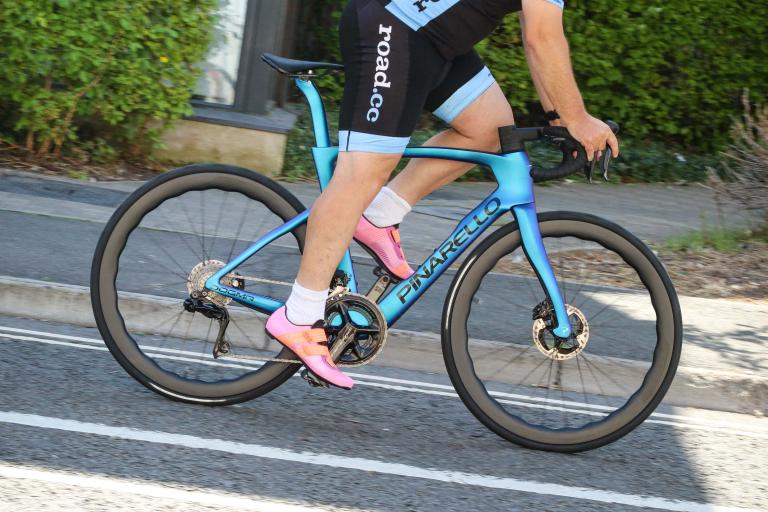

Add new comment
4 comments
So the Hersh Speed is speedy, but harsh? I guess it does what it says on the tin... almost.
250$ OM frame
180$wheelset
250$ finishing kit
350$ group
1030$=600£
and i am being really generous[cost obviously]
Good for consumer at this price. well done
90 bucks wheelset in a 2k costing bike? Those Varos are a bit under the standard...
Those Varos are a bit under the standard...
Surely, in real world conditions, efficient power transfer isn't just about bike stiffness but about creating the conditions for the rider to perform most effectively.
If this bike makes anything other than TdF surfaces feel like cobblestones then won't the rider will perform sub-optimally? I recall (although I can't find it now) an article about a university lecturer who compared his old steel steed with a super-stiff new Cannondale, and found the former slightly faster on his regular commute because it was the much smoother ride. Wouldn't please potential advertisers much to read that though!